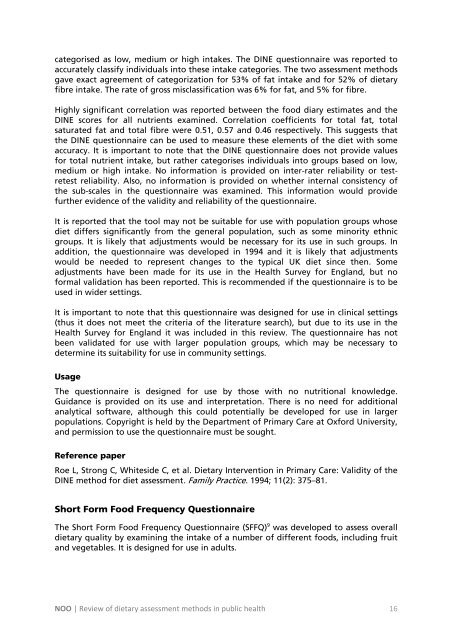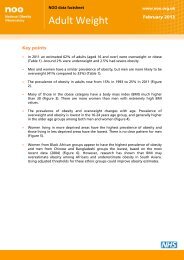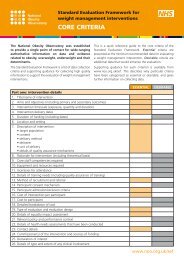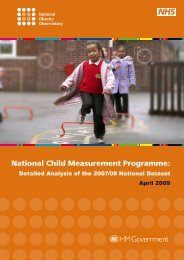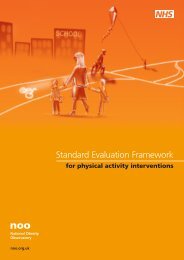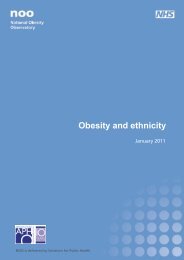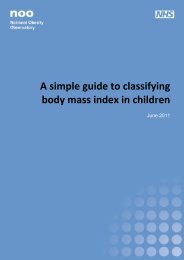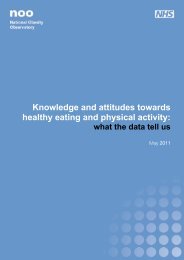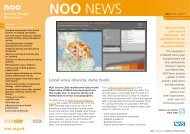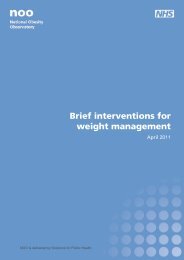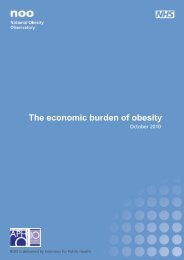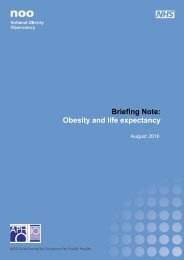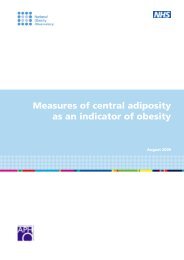Review of dietary assessment methods in public health - National ...
Review of dietary assessment methods in public health - National ...
Review of dietary assessment methods in public health - National ...
You also want an ePaper? Increase the reach of your titles
YUMPU automatically turns print PDFs into web optimized ePapers that Google loves.
categorised as low, medium or high <strong>in</strong>takes. The DINE questionnaire was reported toaccurately classify <strong>in</strong>dividuals <strong>in</strong>to these <strong>in</strong>take categories. The two <strong>assessment</strong> <strong>methods</strong>gave exact agreement <strong>of</strong> categorization for 53% <strong>of</strong> fat <strong>in</strong>take and for 52% <strong>of</strong> <strong>dietary</strong>fibre <strong>in</strong>take. The rate <strong>of</strong> gross misclassification was 6% for fat, and 5% for fibre.Highly significant correlation was reported between the food diary estimates and theDINE scores for all nutrients exam<strong>in</strong>ed. Correlation coefficients for total fat, totalsaturated fat and total fibre were 0.51, 0.57 and 0.46 respectively. This suggests thatthe DINE questionnaire can be used to measure these elements <strong>of</strong> the diet with someaccuracy. It is important to note that the DINE questionnaire does not provide valuesfor total nutrient <strong>in</strong>take, but rather categorises <strong>in</strong>dividuals <strong>in</strong>to groups based on low,medium or high <strong>in</strong>take. No <strong>in</strong>formation is provided on <strong>in</strong>ter-rater reliability or testretestreliability. Also, no <strong>in</strong>formation is provided on whether <strong>in</strong>ternal consistency <strong>of</strong>the sub-scales <strong>in</strong> the questionnaire was exam<strong>in</strong>ed. This <strong>in</strong>formation would providefurther evidence <strong>of</strong> the validity and reliability <strong>of</strong> the questionnaire.It is reported that the tool may not be suitable for use with population groups whosediet differs significantly from the general population, such as some m<strong>in</strong>ority ethnicgroups. It is likely that adjustments would be necessary for its use <strong>in</strong> such groups. Inaddition, the questionnaire was developed <strong>in</strong> 1994 and it is likely that adjustmentswould be needed to represent changes to the typical UK diet s<strong>in</strong>ce then. Someadjustments have been made for its use <strong>in</strong> the Health Survey for England, but n<strong>of</strong>ormal validation has been reported. This is recommended if the questionnaire is to beused <strong>in</strong> wider sett<strong>in</strong>gs.It is important to note that this questionnaire was designed for use <strong>in</strong> cl<strong>in</strong>ical sett<strong>in</strong>gs(thus it does not meet the criteria <strong>of</strong> the literature search), but due to its use <strong>in</strong> theHealth Survey for England it was <strong>in</strong>cluded <strong>in</strong> this review. The questionnaire has notbeen validated for use with larger population groups, which may be necessary todeterm<strong>in</strong>e its suitability for use <strong>in</strong> community sett<strong>in</strong>gs.UsageThe questionnaire is designed for use by those with no nutritional knowledge.Guidance is provided on its use and <strong>in</strong>terpretation. There is no need for additionalanalytical s<strong>of</strong>tware, although this could potentially be developed for use <strong>in</strong> largerpopulations. Copyright is held by the Department <strong>of</strong> Primary Care at Oxford University,and permission to use the questionnaire must be sought.Reference paperRoe L, Strong C, Whiteside C, et al. Dietary Intervention <strong>in</strong> Primary Care: Validity <strong>of</strong> theDINE method for diet <strong>assessment</strong>. Family Practice. 1994; 11(2): 375–81.Short Form Food Frequency QuestionnaireThe Short Form Food Frequency Questionnaire (SFFQ) 9 was developed to assess overall<strong>dietary</strong> quality by exam<strong>in</strong><strong>in</strong>g the <strong>in</strong>take <strong>of</strong> a number <strong>of</strong> different foods, <strong>in</strong>clud<strong>in</strong>g fruitand vegetables. It is designed for use <strong>in</strong> adults.NOO | <strong>Review</strong> <strong>of</strong> <strong>dietary</strong> <strong>assessment</strong> <strong>methods</strong> <strong>in</strong> <strong>public</strong> <strong>health</strong> 16


